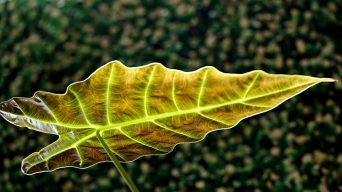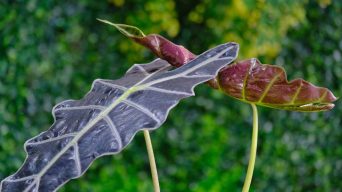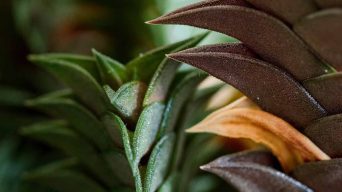A dying Alocasia can suffer from inadequate light, over/underwatering, temperature extremes, low humidity, overfertilization, pests, or diseases. Proper light, watering, humidity, and pest control can revive it. Regular observation and adjustments are key to its health.
Alocasia are beautiful, unique plants that add a touch of the tropics to any home. But these plants are not always easy to care for.
Many people struggle with keeping their Alocasia healthy and wonder why their houseplants are dying.
There are several reasons why an Alocasia may die, but fortunately, there are solutions for each problem.
This article will discuss 11 common causes of Alocasia death and how to solve them.
Identifying Causes and Solutions for a Dying Alocasia
An Alocasia plant can die for several reasons, including:
1. Not Enough Light
One of the most common reasons an Alocasia dies is not getting enough light.
Alocasias are native to tropical regions and need bright, indirect sunlight to thrive.
They need at least 4 hours of bright light daily but can tolerate up to 12 hours of light.
When an Alocasia does not get enough light, it won’t be able to photosynthesize and will eventually die.
Signs of Inadequate Light
There are a few signs that will tell you if your Alocasia isn’t getting enough light:
- The leaves are small and pale
- The stem is thin and spindly
- The plant is not growing
- The plant is leaning toward the light
If you notice any of these signs, your Alocasia needs more light.
Solutions for Light Deficiency
If your Alocasia isn’t getting enough light, you first need to move it to a brighter location.
An east- or west-facing window is ideal.
You can supplement with artificial lighting if you can’t provide enough natural light.
Fluorescent lights are the best type of artificial light for Alocasias.
However, you must ensure that the light is not too close to the plant, which can cause the leaves to burn.
2. Too Much Sunlight
While Alocasias need bright indirect light to thrive, too much sunlight can be as harmful as insufficient light.
If an Alocasia gets too much direct sunlight, the plant will scorch.
Alocasia sunburn manifests as brown or yellow patches on the foliage.
If the sunburn is severe, it can kill the plant.
Identifying Overexposure to Sunlight
There are a few signs that will tell you if your Alocasia is getting too much sunlight:
- Brown or yellow patches on the leaves
- The leaves are wilting
- Wrinkled and crispy leaves
If you notice any of these signs, your Alocasia is getting too much light and needs to be moved to a shadier location.
Remedies for Excessive Sunlight
If your Alocasia is getting too much light, the best thing you can do is move it to a shadier location.
A north- or east-facing window is ideal.
You can also try shading the plant with a sheer curtain or placing it in a room that doesn’t get direct sunlight.
Alocasia plants need bright indirect light to thrive, so ensure that the location you move it to still provides enough light.
3. Too Much Water
One of the most common reasons houseplants die is too much water.
This is especially true for Alocasias.
Alocasias are native to tropical regions and need moist soil to thrive.
However, the soil should never be soggy or wet.
If the roots of an Alocasia are constantly wet, they won’t be able to get the oxygen they need and will eventually die.
Excessive watering increases the vulnerability of an Alocasia to fungal diseases, potentially leading to the plant’s demise.
Recognizing Overwatering
There are a few signs that will tell you if your Alocasia is getting too much water:
- The soil is always wet or soggy
- The leaves are drooping
- The leaves are yellow
- Mushy or soft leaves
- The stem is soft
- The roots are mushy
If you notice these signs, your Alocasia is getting too much water and needs to be watered less.
Correcting Overwatering
If your Alocasia is getting too much water, you first need to stop watering it so often.
Allow the soil to dry out completely before watering again.
You may also need to check the drainage of your pot.
If the pot doesn’t have good drainage, the roots will sit in water and eventually die.
You can add some perlite or sand to the soil to improve drainage.
You may also need to repot your Alocasia into a pot with better drainage.
4. Not Enough Water
While too much water can kill an Alocasia, insufficient water will also damage the plant.
Alocasias need moist soil to thrive.
If the soil is too dry for long periods, the Alocasia leaves will start to droop.
Eventually, the leaves will turn brown and crisp, and the plant may die.
Signs of Underwatering
There are a few signs that will tell you if your Alocasia is getting too little water:
- The soil is dry
- The leaves are drooping
- The leaves are dry or crispy
- The plant growth is stunted
If you notice these signs, your Alocasia needs to be watered.
Addressing Underwatering
If your Alocasia is getting too little water, it is best to water it more often.
You must water your Alocasia at least once a week and more often if the soil is dry.
When watering, make sure to water the soil, not the leaves.
Wetting the leaves can damage them and cause brown spots.
Using a watering can with a shower head attachment is also an excellent idea to water the soil evenly without wetting the leaves.
5. Low Humidity
Alocasias are native to tropical regions and need high humidity to thrive.
The leaves will brown and crisp if the air around your Alocasia is too dry.
Eventually, the plant may die.
Detecting Insufficient Humidity
There are a few signs that will tell you if your Alocasia is getting too little humidity:
- The leaves are dry or crispy
- The leaves are browning
- The plant growth is stunted
If you notice any of these signs, your Alocasia needs more humidity.
Increasing Humidity
If your Alocasia is getting too little humidity, the best thing you can do is increase the humidity around the plant.
You can do this by misting the leaves with water daily or placing the pot on a tray of pebbles and water.
You can also use a humidifier to increase the humidity in the room.
6. Root-Bound Conditions
Alocasias need plenty of room to grow.
If the roots of an Alocasia are cramped and crowded, they won’t be able to get the nutrients and moisture they need, and the plant will start to die.
This is a common problem when Alocasias are grown in pots.
Identifying a Root-Bound Plant
There are a few signs that will tell you if your Alocasia is root-bound:
- The roots are growing out of the drainage holes
- The plant is pot-bound (the roots are filling up the pot)
- The plant is not growing
- The plant is wilting
- The lower leaves are yellow or brown
If you notice these signs, your Alocasia is root-bound and needs to be repotted.
Resolving Root-Bound Issues
If your Alocasia is root-bound, the best thing you can do is repot it into a larger pot.
Choose a pot that is at least 2 inches larger in diameter than the current pot.
Fill the new pot with fresh, well-draining potting soil.
Carefully remove the Alocasia from its current pot and loosen the roots before placing it in the new pot.
You may need to trim the roots if they are excessively long.
7. Cold Temperatures
Alocasias are tropical plants and need warm temperatures to thrive.
If the temperature drops too low, the alocasia leaves will brown and crisp.
Alocasia plants thrive in temperatures between 60-85 degrees Fahrenheit.
If the temperature drops below 60 degrees Fahrenheit, the plant will experience stress.
If the temperature drops below 50 degrees Fahrenheit, the plant will die.
Spotting Cold Stress
There are a few signs that will tell you if your Alocasia is experiencing cold stress:
- The leaves lose their color
- The plant growth is stunted
- The plant is wilting
- The plant becomes mushy and turns black
- The leaves start to curl
If you notice these signs, your Alocasia is experiencing cold stress and needs to be moved to a warmer location.
Protecting From Cold
If your Alocasia is experiencing cold stress, the best thing you can do is move it to a warmer location.
If the temperature is too cold, you can move the plant to a sunnier location.
If the temperature is too cold, you may need to move the plant indoors or into a greenhouse.
You can also use a heat lamp to create a warm, humid environment around the plant.
8. Hot Temperatures
Alocasias are tropical plants and need warm temperatures to thrive.
However, the leaves will brown and crisp if the temperature gets too hot.
Alocasias plants thrive in temperatures between 60-85 degrees Fahrenheit.
If the temperature rises above 85 degrees Fahrenheit, the plant will experience stress.
If the temperature rises above 95 degrees Fahrenheit, the plant will die.
Recognizing Heat Stress
There are a few signs that will tell you if your Alocasia is experiencing heat stress:
- The leaves’ edges turn brown
- Yellowing leaves
- The plant growth is stunted
- The plant is wilting
If you notice any of these signs, your Alocasia is experiencing heat stress and needs to be moved to a cooler location.
Mitigating Heat Stress
If your Alocasia is experiencing heat stress, the best thing you can do is move it to a cooler location.
If the temperature is too hot, you can move the plant to a shadier location.
If the temperature is too hot, you may need to move the plant indoors or into a cooler room.
You may also need to mist the plant more frequently to cool it down and help it recover.
9. Overfertilization
Alocasias are susceptible to overfertilization, leading to several problems, including root burn, leaf burn, and plant death.
Overfertilization results from excessive fertilizer application to a plant, leading to potential yellowing or browning of Alocasia leaves and root damage.
It is essential to fertilize your Alocasia only during the growing season and use a fertilizer specifically designed for tropical plants.
Detecting Overfertilization
There are a few signs that will tell you if your Alocasia is experiencing overfertilization:
- The lower leaves turn yellow and wilt
- Leaf tips turn brown and curl
- The plant stops growing
- The roots are damaged or blackened
If you notice any of these signs, your Alocasia is experiencing overfertilization and must be flushed with water.
Correcting Overfertilization
If your Alocasia is experiencing overfertilization, the best thing you can do is flush the plant with water.
To do this, water the plant deeply and then allow the excess moisture to drain away.
You may need to flush the plant several times to remove all the fertilizer from the soil.
You may also need to repot the plant in a fresh, sterile potting mix.
10. Pest Infestation
Alocasias are susceptible to several pests, including aphids, mealybugs, spider mites, and scale insects.
Aphids, mealybugs, and spider mites can all cause the leaves to turn yellow or brown and become distorted.
Scale insects can cause the plant to become stunted and can eventually kill the plant.
Identifying Pest Problems
There are a few signs that will tell you if your Alocasia is infested with pests:
- The leaves are yellow or drop off
- The leaves are covered in a sticky substance
- The leaves are covered in webbing
- The leaves have holes
- The plant is stunted or slow-growing
- Insects are crawling on the plant
If you notice these signs, your Alocasia is infested with pests and needs treatment.
Treating Pest Infestations
You must first isolate the plant if your Alocasia is infested with pests.
This will prevent the pests from spreading to other plants.
Next, you need to remove the pests from the plant.
You can do this by hand or with a sharp stream of water.
You may also need to treat the plant with a natural pesticide, such as neem oil.
11. Disease
Alocasias are susceptible to several diseases, including root rot, leaf spot, and blight.
Root rot is the most serious of these diseases and can quickly kill the plant.
Leaf spot and blight can cause the leaves to turn yellow or brown and to become distorted.
Recognizing Signs of Disease
There are a few signs that will tell you if your Alocasia has a disease:
- The leaves will turn yellow or brown
- The leaves will become distorted
- The plant will stop growing
- The plant will wilt
- Brown or black spots will appear on the leaves
- The leaves will drop off
If you notice any of these signs, your Alocasia has a disease that needs treatment.
Managing Plant Diseases
If your Alocasia has a disease, the first thing you need to do is isolate the plant.
This will prevent the disease from spreading to other plants.
Next, you need to remove the affected leaves and stems.
You may also need to treat the plant with a natural fungicide, such as neem oil.
Changing the potting mix and sterilizing the pot to prevent the disease from returning are also essential.
Preventing Alocasia Plants From Dying
To prevent Alocasia plant deaths, adopt a comprehensive care strategy covering various aspects.
Here’s a practical guide to maintain the vitality of your Alocasia:
- Optimal Lighting: Alocasia plants thrive in bright, indirect light. Avoid direct sunlight, as it can harm the leaves. If natural light is insufficient, consider using a grow light.
- Proper Watering: Over-watering is a common cause of Alocasia’s demise. Use well-draining soil and water only when the top inch feels dry. Decrease watering during colder months.
- Humidity and Temperature: These tropical plants require high humidity. Achieve this with a humidifier, misting the leaves, or placing a water tray nearby. Keep them in a warm environment, avoiding temperatures below 60°F (15°C).
- Soil and Fertilization: Utilize a well-draining potting mix, ideally formulated for aroids. Fertilize with a balanced, water-soluble fertilizer every 4-6 weeks during the growing season.
- Pest Management: Regularly inspect your Alocasia for signs of pests like spider mites, aphids, or mealybugs. Promptly address infestations with insecticidal soap or neem oil.
- Regular Maintenance: Trim yellow or dead leaves to stimulate new growth. Clean leaves with a damp cloth to remove dust, aiding photosynthesis.
- Potting and Repotting: Repot every few years or when root-bound to promote healthy growth and refresh the soil.
- Observation and Adjustment: Every Alocasia plant is unique. Observe its response to the environment and adjust care routines accordingly. For example, if leaves droop, it may need more water or less light.
Adhering to these guidelines can create an ideal environment for your Alocasia, significantly lowering the risk of mortality and ensuring its long-term health and beauty.
Final Thoughts
As you can see, there are several reasons an Alocasia might die.
However, if you catch the problem early, there’s a good chance that you can save your indoor plant.
So, if your Alocasia is dying, don’t give up hope just yet!
The first thing you need to do is figure out what’s causing the problem.
Once you’ve done that, you can take the necessary steps to save your plant.







